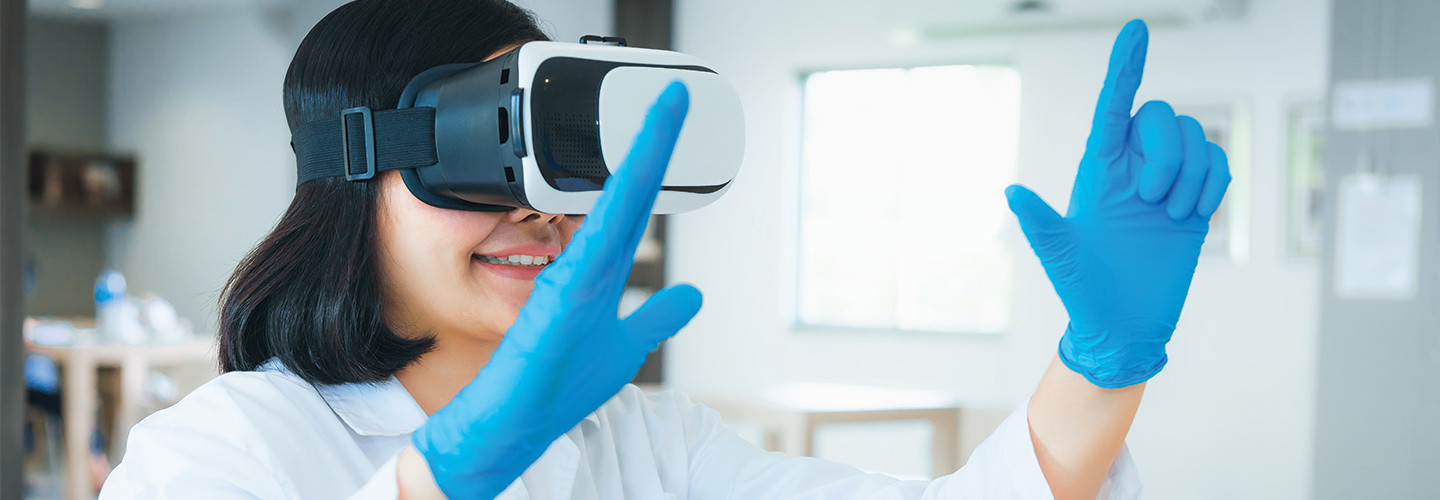
Key aspects of orthopedic VR surgery include learning the correct steps for a procedure and shooting an X-ray at the right angle, according to Mazzocca. Students also learn how to perform a reduction of a fractured bone, which involves setting a broken bone through pushing and pulling so the ends line up correctly. VR lets students practice knee or shoulder replacement or pinning fractures many times without having to practice on live patients, he explains.
Mazzocca considers the field of VR to be at the “ground floor.” He says VR is not mainstream yet, but he sees room for growth to include all areas of orthopedic surgery, including hip fractures, ACL reconstructions and shoulder instability operations.
VR in medicine will “continue to grow and be better, but right now, I think it’s terrific for student and resident education,” Mazzocca says.
AR Medical Training Provides a Graphic Look Inside the Body at UCF
The University of Central Florida College of Nursing implemented AR and VR for nurses and nurse practitioners over the past year, says Mindi Anderson, interim associate dean for simulation and immersive learning and director of the school’s healthcare simulation graduate program.
One of the benefits of using AR and VR comes from a look inside the anatomy of the human body. “There are scenarios where the student can walk inside the body and see what’s happening behind the scenes with that pathophysiology, anatomy and physiology, so they can really get that understanding of what is happening with the patient. This can help with interventions,” Anderson says.
Students can see, for example, what happens during a stroke or heart attack, she says. One way UCF has used AR is to prepare students to participate in a manikin-based simulation with similar content, Anderson says.
With AR, users can see the environment around them. “I could see the floor, but now I see a holographic patient in a bed on that floor as opposed to virtual reality, where everything is blocked out from your vision,” Anderson explains.
EXPLORE: How virtual reality and extended reality are advancing patient care.
UCF uses both Microsoft HoloLens and Oculus headsets, as well as a variety of prepackaged simulations. The school chooses cases in which real-life simulations would be challenging, including maternity complications such as postpartum hemorrhage. In maternal care, an image can be overlayed on a manikin’s abdomen, Anderson says.
“In AR, they can see a normal birth, and they could see a birth that didn’t go right,” Anderson says. “This allows learners the opportunity to recognize something that is not normal and intervene earlier, thus, leading to improved patient outcomes.”
Best Practices for Implementing AR and VR in Healthcare
Brown offers the following suggestions when using AR and VR for medical training:
Use multiplayer scenarios. Train together with teams of nurses and physicians, rather than in a silo. “You don’t work in your bubble; you work with a team,” Brown says. “Where you have a single player, that’s fine, but in the real world, you’re not working as a single player, you’re working as a collaborative team.”
Prioritize practice. Take advantage of the ability to practice repeatedly in AR and VR.
“You want to get that learner to feel a little bit stressed so they can then practice over and over again,” Brown says, “So when the stressful situation happens, they can manage it, they’ve seen it before, and they feel more comfortable. We were able to give our learners an opportunity to practice and to make decisions in real time and repeat it, which was really important.”
This article was originally published on healthtechmagazine
